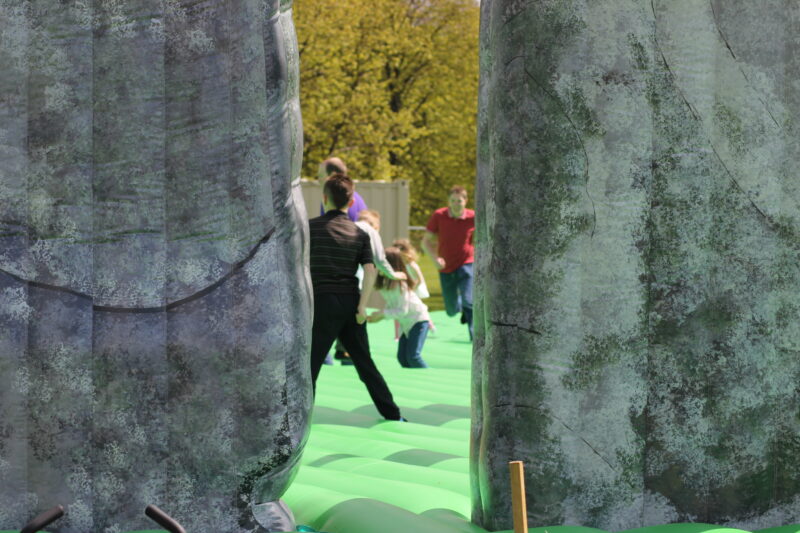
Introduction
Have you ever wondered what it would be like to physically interact with an ancient monument like Stonehenge? Jeremy Deller’s 1 Sacrilege turns this idea into reality by recreating the iconic structure as a giant inflatable 2 bouncy castle.
This playful 3 and thought-provoking installation 4 invites people of all ages to bounce, roll, and jump on a life-sized, blow-up version of one of the world’s most mysterious prehistoric sites. Far from just a whimsical experience, Sacrilege offers a unique way to engage with history, art, and contemporary culture all at once.

Technical details
Sacrilege is an impressive feat of both art and engineering. Created in 2012, this inflatable Stonehenge measures 35 meters in diameter, mirroring the size of the original monument.
Stonehenge is indeed quite large, but it’s difficult to appreciate its scale since it’s been cordoned off since 1977, making it hard to get close to it. In an interview with Artforum 56, Deller described this “restriction as an opportunity“.

The structure is made from durable, reinforced PVC, similar to the material used in commercial bouncy castles, ensuring it can withstand the wear and tear of enthusiastic visitors.
The project required a large team of designers, engineers, and fabricators to bring it to life, taking several months to complete. The installation is inflated using industrial-grade blowers, and once fully erected, it stands as a colorful and slightly surreal version of the ancient stones.
Interactive & participatory elements
What makes Sacrilege stand out is its interactive 7 nature. Unlike traditional artworks that are meant to be observed from a distance, this piece encourages direct physical engagement.
Visitors are not just allowed but encouraged to bounce on the inflatable stones, transforming the typically solemn experience of visiting Stonehenge into something joyful and accessible. This interaction breaks down the barriers between the artwork and the audience, making it a communal experience that invites everyone to participate, regardless of age or background.

Public reception & controversies
When Sacrilege was first unveiled, it was met with a mix of delight and criticism. Many praised the installation for its playful approach to a cultural icon, seeing it as a refreshing way to engage with history.
Others, however, found the idea of turning Stonehenge into a bouncy castle disrespectful, arguing that it trivializes an important historical site. Despite the controversy 8, Sacrilege proved to be immensely popular, attracting thousands of visitors wherever it was installed, from the London 9 Olympics to various locations worldwide.
In a conversation with Massimiliano Gioni 1011, Deller described the process of finding the right name for the artwork:
That’s what I called it back in 2012 and that’s how it stayed, people seem to like it. At the time I thought people may think turning a pre-historic site in to a bouncy castle sacrilege, so to ward off any criticism I called it just that.
Cultural & social context
Jeremy Deller’s decision to create an inflatable Stonehenge was deeply rooted in the cultural and social context of the time. Sacrilege was conceived during a period when public engagement with art was becoming increasingly important.
Deller, known for his socially engaged works, wanted to create something that would break down the elitism often associated with both art and historical monuments. The artist described Sacrilege 1213 as a way to get reacquainted with ancient Britain with your shoes off.
By transforming Stonehenge into something playful and accessible, he challenged traditional notions of how we interact with history and culture. The work also reflects a broader trend in contemporary art that emphasizes participation, community, and the democratization of art.

Symbolism & themes
Sacrilege is rich in symbolism. On one level, it can be seen as a commentary on the commercialization and commodification of cultural heritage 14. By turning Stonehenge into a bouncy castle, Deller is playfully critiquing how historical sites are often reduced to mere tourist attractions. At the same time, the work also speaks to the idea of play as a universal language.
By inviting people to engage with history in a fun and physical way, Sacrilege suggests that history is not just something to be preserved and revered but something to be experienced and enjoyed. According to Deller, the importance of Stonehenge as a cultural heritage site can’t be understated. He said in an interview 1516:
Stonehenge is always present in a sense. It’s always present in our lives. There’s always something happening there that we think about. It represents us.

Final words
Jeremy Deller’s Sacrilege is much more than just an inflatable bouncy castle; it’s a bold reimagining of how we engage with history and art. By making something as iconic and untouchable as Stonehenge into a playground, Deller invites us to rethink the ways in which we interact with cultural heritage.
Whether you see it as a playful tribute or a provocative statement, Sacrilege leaves a lasting impression. Would you jump at the chance to bounce on history?

